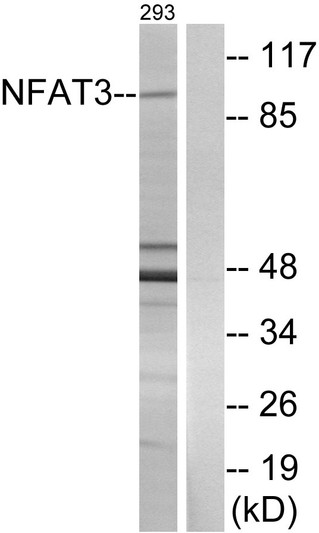| Tissue Specificity | Widely expressed, with high levels in placenta, lung, kidney, testis and ovary. Weakly expressed in spleen and thymus. In the hippocampus, expressed in the granular layer of the dentate gyrus, in the pyramidal neurons of CA3 region, and in the hippocampal fissure. Expressed in the heart (at protein level). |
| Post Translational Modifications | Phosphorylated by NFATC-kinases.dephosphorylated by calcineurin/PPP3CA. Phosphorylated on Ser-168 and Ser-170 by MTOR, IRAK1, MAPK7/ERK5 and MAPK14/p38, on Ser-213 and Ser-217 by MAPK8/JNK1 and MAPK9/JNK2, and on Ser-289 and Ser-344 by RPS6KA3. Phosphorylated by GSK3B. Phosphorylation by GSK3B markedly increases NFATC4 ubiquitination. Phosphorylation at Ser-168 and Ser-170 is stimulated by UV irradiation. Phosphorylation determines subcellular location: the hyperphosphorylated protein is cytosolic, while the dephosphorylated form is targeted to the nucleus. Ubiquitinated, leading to degradation by the proteasome. Ubiquitination may be stimulated by GSK3B-dependent phosphorylation. Polyubiquitin linkage mainly occurs through 'Lys-48'. |
| Function | Ca(2+)-regulated transcription factor that is involved in several processes, including the development and function of the immune, cardiovascular, musculoskeletal, and nervous systems. Involved in T-cell activation, stimulating the transcription of cytokine genes, including that of IL2 and IL4. Along with NFATC3, involved in embryonic heart development. Following JAK/STAT signaling activation and as part of a complex with NFATC3 and STAT3, binds to the alpha-beta E4 promoter region of CRYAB and activates transcription in cardiomyocytes. Involved in mitochondrial energy metabolism required for cardiac morphogenesis and function. Transactivates many genes involved in the cardiovascular system, including AGTR2, NPPB/BNP (in synergy with GATA4), NPPA/ANP/ANF and MYH7/beta-MHC. Involved in the regulation of adult hippocampal neurogenesis. Involved in BDNF-driven pro-survival signaling in hippocampal adult-born neurons. Involved in the formation of long-term spatial memory and long-term potentiation. In cochlear nucleus neurons, may play a role in deafferentation-induced apoptosis during the developmental critical period, when auditory neurons depend on afferent input for survival. Binds to and activates the BACE1/Beta-secretase 1 promoter, hence may regulate the proteolytic processing of the amyloid precursor protein (APP). Plays a role in adipocyte differentiation. May be involved in myoblast differentiation into myotubes. Binds the consensus DNA sequence 5'-GGAAAAT-3' (Probable). In the presence of CREBBP, activates TNF transcription. Binds to PPARG gene promoter and regulates its activity. Binds to PPARG and REG3G gene promoters. |
| Protein Name | Nuclear Factor Of Activated T-Cells - Cytoplasmic 4Nf-Atc4Nfatc4T-Cell Transcription Factor Nfat3Nf-At3 |
| Cellular Localisation | CytoplasmNucleusWhen HyperphosphorylatedLocalizes In The CytosolWhen Intracellular Ca(2+) Levels IncreaseDephosphorylation By Calcineurin/Ppp3ca Leads To Translocation Into The NucleusMapk7/Erk5 And Mtor Regulate Nfatc4 Nuclear Export Through Phosphorylation At Ser-168 And Ser-170 |
| Alternative Antibody Names | Anti-Nuclear Factor Of Activated T-Cells - Cytoplasmic 4 antibodyAnti-Nf-Atc4 antibodyAnti-Nfatc4 antibodyAnti-T-Cell Transcription Factor Nfat3 antibodyAnti-Nf-At3 antibodyAnti-NFATC4 antibodyAnti-NFAT3 antibody |
Information sourced from Uniprot.org











